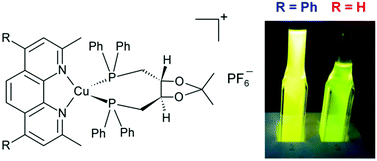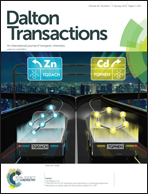Highly emissive copper(i) complexes bearing diimine and bis(diphenylphosphinomethyl)-2,2-dimethyl-1,3-dioxolane†
Abstract
A highly emissive copper(I) complex bearing (4R,5R)-(−)-4,5-bis(diphenylphosphinomethyl)-2,2-dimethyl-1,3-dioxolane (diop) and 2,9-dimethyl-4,7-diphenyl-1,10-phenanthroline (dmpp), [Cu(dmpp)(diop)]PF6 (1·PF6), was newly synthesized. The quantum yield of the luminescence of 1·PF6 in degassed dichloromethane is 0.38, which is one of the highest values among all copper(I) complexes bearing two bidentate ligands, diimine and diphosphine, under the same conditions. The long lifetime (26 μs) and high intensity of the emission come from the small non-radiative decay rate of the excited states. The TD-DFT study indicates that the charge transfer transition from both copper and diphosphine to diimine orbitals plays an important role in the photophysical properties. Photophysics of [Cu(dmp)(diop)]PF6 (2·PF6, dmp = 2,9-dimethyl-1,10-phenanthroline) was also studied in order to reveal the effects of the introduction of the phenyl group at 4- and 7-positions of phenanthroline.


 Please wait while we load your content...
Please wait while we load your content...